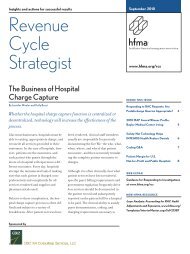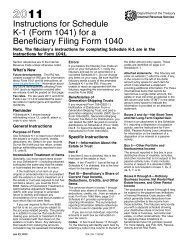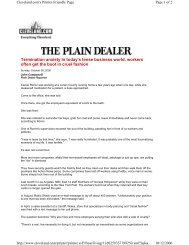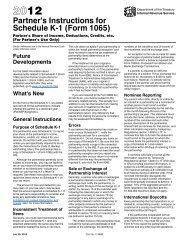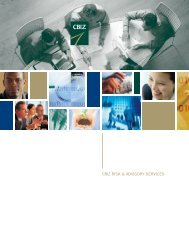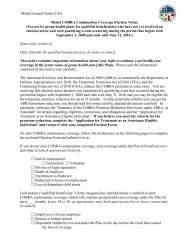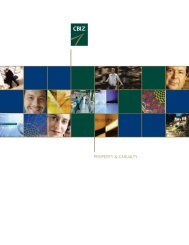Internal Claims and Appeals, and External Review Process - CBIZ
Internal Claims and Appeals, and External Review Process - CBIZ
Internal Claims and Appeals, and External Review Process - CBIZ
Create successful ePaper yourself
Turn your PDF publications into a flip-book with our unique Google optimized e-Paper software.
Subject: <strong>Internal</strong> <strong>Claims</strong> <strong>and</strong> <strong>Appeals</strong>, <strong>and</strong> <strong>External</strong> <strong>Review</strong> <strong>Process</strong>Date: July 26, 2010On July 23, 2010, the Departments of HHS, Labor, <strong>and</strong> Treasury issued interim final regulationsrelating to the internal claims <strong>and</strong> appeal, <strong>and</strong> external review process provisions of the healthreform law (PPACA). These rules provide for both a st<strong>and</strong>ardized internal process, as well asan external process, that individuals can use to appeal decisions made by their health plan.These regulations apply to plans on the first day of the first plan year beginning on or afterSeptember 23, 2010. The rules apply to non-gr<strong>and</strong>fathered plans, <strong>and</strong> plans that losegr<strong>and</strong>fathered status.<strong>Internal</strong> <strong>Claims</strong> <strong>and</strong> <strong>Appeals</strong> <strong>Process</strong>In general, insured <strong>and</strong> self-funded group health plans, subject to ERISA, have been required tocomply with a structured claims <strong>and</strong> appeals process, as set forth by the Department of Labor.The new interim rules extend these rules to plans exempt from ERISA, <strong>and</strong> add the following sixrequirements:1. Clarification of Adverse Determinations. The regulations broaden the definition of an‘adverse benefit determination’ to include a rescission of coverage. An adverse benefitdetermination is eligible for an internal claims <strong>and</strong> appeals process when there is abenefit denial, reduction, or termination, or a failure to make payment for a benefit, whenbased on:• Eligibility;• A non-covered benefit;• A preexisting condition exclusion, source-of-injury exclusion, network exclusion,or other limitation; or• A benefit that is experimental, investigational, or not medically necessary orappropriate.2. Expedited Notification of Urgent Care <strong>Claims</strong>. These rules require urgent carematters to be addressed as soon as possible, but, in no event, longer than 24 hours.3. Full <strong>and</strong> fair review. Claimants must be allowed to review their claim file, <strong>and</strong> to presentevidence <strong>and</strong> testimony as part of the internal claims <strong>and</strong> appeals process. Plans mustprovide the claimant, free of charge, with any new or additional evidence relied upon, orgenerated by the plan, as well as the rationale used to make the determination.4. Avoiding conflicts of interest. The rules specify st<strong>and</strong>ards that must be satisfied toavoid a conflict of interest between all parties involved in the claims <strong>and</strong> appeals process.July 26, 2010 Page 1
<strong>CBIZ</strong> Health Reform Bulletin5. Notice of Adverse Determinations. Plans must provide its notice of adversedetermination in a culturally <strong>and</strong> linguistically appropriate manner (see Disclosure <strong>and</strong>Notices, below). What this means is that plans must ensure that the adversedetermination notice provided to a claimant includes:• Information sufficient to identify the claim involved;• The reason/rationale for the adverse benefit determination;• A description of any available internal or external review process; <strong>and</strong>• Contact information for any consumer assistance or ombudsman office to assistindividuals with their claim review.6. Deemed exhaustion of internal claims <strong>and</strong> appeals processes. If a plan fails tofollow the explicit requirements of the law, a claimant will have the right to proceed to thenext level of appeal.<strong>External</strong> <strong>Review</strong> <strong>Process</strong>In the event of an adverse determination, an individual will have the right to appeal to anindependent third party through an external appeal process. Currently, many states haveexternal appeals processes in place. States will be given one year to bring their processes intocompliance with this law. States that do not currently offer an external review will have the rightto adopt compliant procedures.In the event that a state does not require insurers to follow an external review process, a federalexternal review procedure will be required. The federal procedure will also govern self-fundedplans exempt from state law <strong>and</strong> subject to ERISA.Continuance of Benefits during an <strong>Internal</strong> or <strong>External</strong> Claim <strong>Review</strong>Plans are required to continue coverage pending the outcome of an appeal. Benefits for anongoing course of treatment cannot be reduced or terminated without providing advance notice,<strong>and</strong> an opportunity for advance review.Disclosure <strong>and</strong> NoticesBoth the internal <strong>and</strong> external review processes must be described in the summary pl<strong>and</strong>escription, or other description of coverage.Model claim <strong>and</strong> appeal notices will be developed by the DOL. These notices must be providedin a ‘culturally <strong>and</strong> linguistically appropriate manner’, depending on the number <strong>and</strong> majoritylanguage of the participants:• For plans covering fewer than 100 participants at the beginning of a plan year, theinsurer/plan must provide notices upon request in a non-English language in which 25%or more of all plan participants are literate only in the same non-English language; or• For a plan that covers 100 or more participants at the beginning of a plan year, theinsurer/plan must provide notices upon request in a non-English language in which thelesser of 500 or more participants, or 10% or more of all plan participants, are literateonly in the same non-English language.In any English versions of notice required to be provided, a plan must also include a statement,in non-English, that its notices can be obtained in the non-English language. Once a requesthas been made by a claimant, the plan must provide all subsequent notices to the claimant inthe non-English language. To the extent the insurer/plan maintains a customer assistanceprocess, such as a telephone hotline, that answers questions or provides assistance with filingclaims <strong>and</strong> appeals, the insurer/plan must provide such assistance in the non-English language.July 26, 2010 Page 2
<strong>CBIZ</strong> Health Reform BulletinAdditional information:• EBSA Fact Sheet: The Affordable Care Act: Protecting Consumers <strong>and</strong> Putting PatientsBack in Charge of Their Care• NAIC’s Uniform Health Carrier <strong>External</strong> <strong>Review</strong> Model ActAbout the Author: Karen R. McLeese is Vice President of Employee Benefit Regulatory Affairsfor <strong>CBIZ</strong> Benefits & Insurance Services, Inc., a division of <strong>CBIZ</strong>, Inc. She serves as in-housecounsel, with particular emphasis on monitoring <strong>and</strong> interpreting state <strong>and</strong> federal employeebenefits law. Ms. McLeese is based in the <strong>CBIZ</strong> Leawood, Kansas office.The information contained herein is not intended to be legal, accounting, or other professional advice, nor are thesecomments directed to specific situations. The information contained herein is provided as general guidance <strong>and</strong> maybe affected by changes in law or regulation. This information is not intended to replace or substitute for accounting orother professional advice. You must consult your own attorney or tax advisor for assistance in specific situations.This information is provided as-is, with no warranties of any kind. <strong>CBIZ</strong> shall not be liable for any damageswhatsoever in connection with its use <strong>and</strong> assumes no obligation to inform the reader of any changes in laws or otherfactors that could affect the information contained herein.As required by U.S. Treasury rules, we inform you that, unless expressly stated otherwise, any U.S. federal taxadvice contained herein is not intended or written to be used, <strong>and</strong> cannot be used, by any person for the purpose ofavoiding any penalties that may be imposed by the <strong>Internal</strong> Revenue Service.July 26, 2010 Page 3



